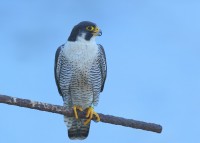Peregrine Falcon: Haverhill male perched on rebar…
June 15, 2016 in Peregrine Falcons Haverhill
 Under bright sunny skies, the male peregrine with leg bands (72/AB) was observed perched on the outstretched piece of rebar from the bridge. in the morning the rebar remains in the shade until much later in the morning. The peregrine was unfazed by nearby light pedestrian traffic this morning. This side view provides an informative view of it’s bill and more specifically, the tomial tooth.
Under bright sunny skies, the male peregrine with leg bands (72/AB) was observed perched on the outstretched piece of rebar from the bridge. in the morning the rebar remains in the shade until much later in the morning. The peregrine was unfazed by nearby light pedestrian traffic this morning. This side view provides an informative view of it’s bill and more specifically, the tomial tooth.
Found in falcons, kites, and accipiters, the TOMIAL TOOTH is the outer, or cutting edge of of the beak. This “tooth” is the protrusion that extends from the tomial edge of the beak and is thought to be used to deliver the killing blow to prey. The tomial tooth of the upper mandible is often matched by a mandibular notch, or divot, in the lower mandible.
This tomial tooth system is important because not all raptors rely solely on their muscular feet and talons to dispatch their prey. Birds like falcons may grab their prey and then use the lever-powered beak to sever the spinal cord of the prey that they catch. They slide their beak over the neck of their prey and use the upper and lower mandible to sever the spinal column. This sounds cruel, but it’s quite efficient and puts the prey out of discomfort very quickly.
